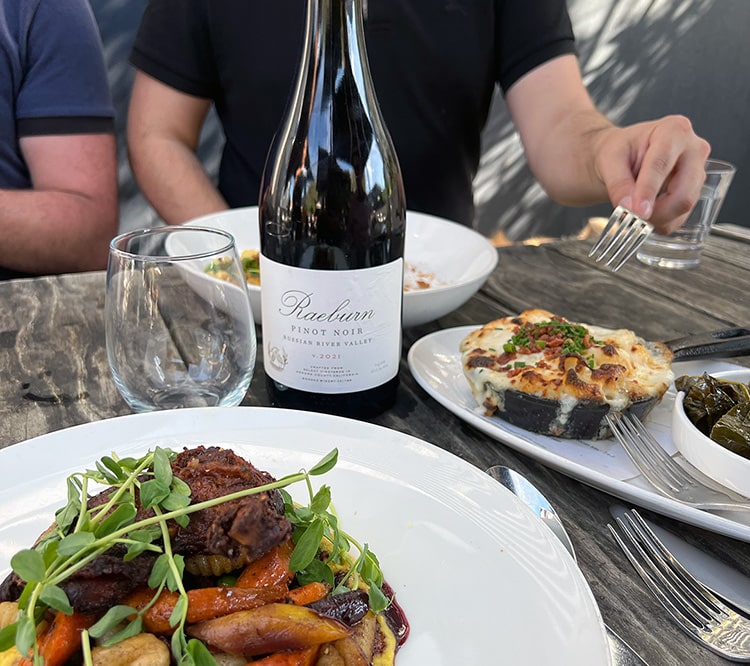What’s better than a glass of wine? A glass of wine along with a delicious meal. While wine can definitely be enjoyed and pondered over on its own, when matched with food, the flavor sensation can be even great than the sum of its parts. We don’t adhere to strict rules but want to provide some general guidelines to help you create your own perfect pairings. Come along with us on a Wine 101 pairing journey.
Mirror the Intensity of Wine and Food
The first important step is to consider the overall flavor profile and intensity of your wine. Aim to find some harmony, mirroring flavors. Matching the wine’s intensity with the food’s intensity is also key—the more flavorful the food, the more flavorful the wine that should be drunk with it. It is more about the textural mouthfeel and weight of the wine than the color, but in general, lighter wines like whites or rosés often pair well with lighter dishes like salads, seafood, and poultry. Fuller-bodied wines, such as red wines, complement heavier dishes like red meats and rich sauces.
A rich, buttery Chardonnay perfectly accompanies lobster drenched in butter because they are both weighty on the palate. The rich body weight of each mirrors each other. Likewise, a Pinot Noir with a lighter profile perfectly pairs with a pasta mushroom dish. Once again, the weight and texture of each reflect one another.
Conversely, if you served a bold Cabernet Sauvignon with Petrale Sole, the delicate flavor of the fish would be tasteless paired with the wine’s intensity of flavors and muscular tannins on the palate. But a crisp and lightly aromatic Sauvignon Blanc matches and reflects the lovely subtleness of the fish and makes for a perfect accompaniment. An excellent, dry Rosé might be overwhelmed with an intense dish, such as a sticky, gooey bar-b-que sauce on a rack of pork ribs but would be a beautiful match with shellfish or creamy cheese.
Balance Flavors on the Palate
Besides mirroring, another pairing element is balancing flavors. Picture how an oil and vinegar salad dressing is created. The two seeming opposites unite to create a balanced dressing. If you poured only vinegar onto the salad, it would be tart and harsh, and if it were all oil, it would change the delicate crispness of the lettuce leaves and leave a buttery aftertaste. Yet, together, the two opposites balance each other and make for a delightful gastronomic experience. Pairing uniquely particular components of wines with the uniquely specific components of foods achieves that same balance.
Let’s explore the building blocks of balancing wine with food based on wine’s primary components: acidity, tannins, and sweetness (or dryness).
Balance Acidity: High-acid wines tend to pair well with salty foods. Salt and acid counterbalance one another on the palate and are natural magnets for each other. Try salty cheeses like a good Parmigiano-Reggiano or French fries with a wine that has good acidity, such as a Sauvignon Blanc or dry sparkling wine. A warm fondue served with a bone-dry and high-acid wine is sublime. Salty and creamy foods decrease the perception of acidity on the palate and help “soften” the acidic elements in the wine.
Tannins Love Protein and Fat: Tannic wines such as Cabernet Sauvignon pair beautifully with foods high in protein and fat, like steak or lamb. Balancing the immense structure of a tannic wine such as Cabernet Sauvignon takes foods with high protein and high-fat characteristics, which helps soften the wine’s astringent mouthfeel created by the tannins. This principle works in the classic pairing of Pinot Noir and roasted lamb. Pinot Noir is also delicious, with long-simmering meat dishes full of butter and fat, like coq au vin. The pairing of a Pinot Noire elevates any crock-pot dinner!
Consider Fruit: Fruity wines pair nicely with spicy or salty foods, as the lushness can counterbalance the heat or saltiness. For example, a fruity wine can perfectly complement spicy, hot Thai or Szechuan dishes.
Match the Moods
Finally, this is about matching your wines to the occasion. Your Monday night casserole is probably not the time to pull out a super-premium wine you’ve been saving. Pair your wines to match the mood and occasion of the meal. A casual dish like Spaghetti Bolognese doesn’t demand an expensive wine pairing. Conversely, an extravagant Filet Mignon with creamy peppercorn sauce might be the ideal opportunity to uncork that special bold, velvety Cabernet Sauvignon you’ve tucked away. The right wine can elevate an entire evening.
Raeburn Winery’s Quick Tips for Pairing with Our Wines
Chardonnay: Seafood with butter or a rich sauce (crab, lobster, scallops); baked and sauteed chicken dishes; salmon; pasta with creamy sauces; and pork dishes (this includes bacon and ham)!
Sauvignon Blanc: Fresh goat cheeses, salads, all vegetables, light fish dishes, sushi and sashimi, and vegetable pasta dishes.
Rosé: This wine can make garlicky food rise to new levels. Cioppino filled with garlic broth and paired with Raeburn’s Rosé is divine. Also, cheesy dishes, including macaroni and cheese or grilled cheese sandwiches, are a Rose’ pairing made in Heaven.
Pinot Noir: Foods that are “earthy,” such as sauteed mushrooms, duck confit, game birds, long simmered and crock-pot dishes, roast lamb, grilled veal chops, and, if not in the mood for a Chardonnay, a rich fish like salmon and Pinot Noir work well together.
Cabernet Sauvignon: Grilled steak is the quintessential pairing for Cabernet Sauvignon. The seared, crusty exterior and the dense inside of a grilled steak mirror Cabernet’s complex structure and richly bold core. Cabernet Sauvignon also works well with all varieties of lamb dishes if you want an alternative to lamb and Pinot Noir.
We can’t wait to hear about your favorite combinations. Follow along on social media, and let us know how you pair your Raeburn wines!


